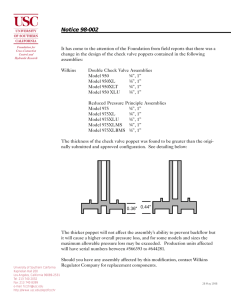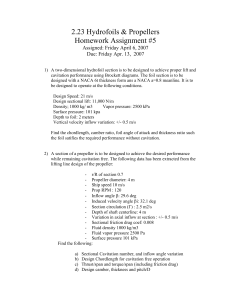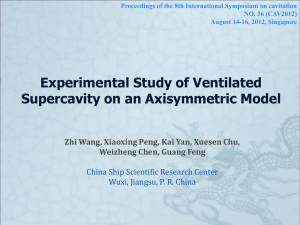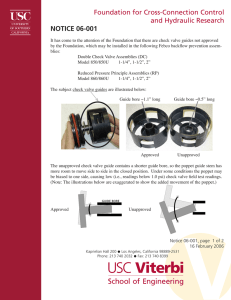Document 15281528
advertisement
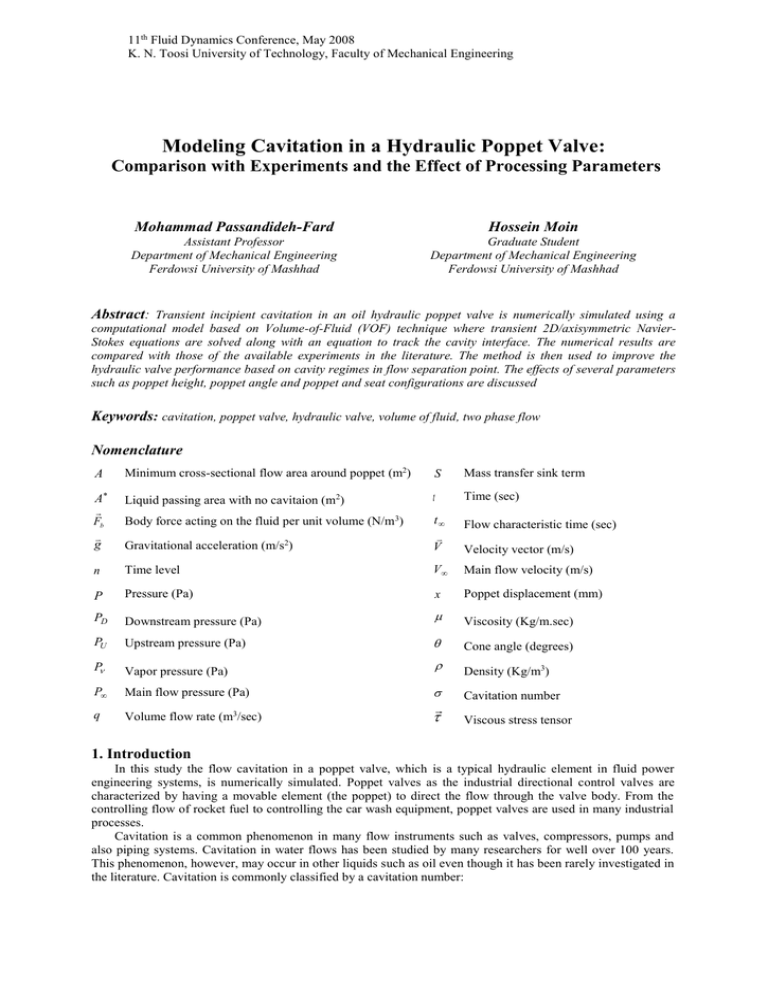
11th Fluid Dynamics Conference, May 2008 K. N. Toosi University of Technology, Faculty of Mechanical Engineering Modeling Cavitation in a Hydraulic Poppet Valve: Comparison with Experiments and the Effect of Processing Parameters Mohammad Passandideh-Fard Hossein Moin Assistant Professor Department of Mechanical Engineering Ferdowsi University of Mashhad Graduate Student Department of Mechanical Engineering Ferdowsi University of Mashhad Abstract: Transient incipient cavitation in an oil hydraulic poppet valve is numerically simulated using a computational model based on Volume-of-Fluid (VOF) technique where transient 2D/axisymmetric NavierStokes equations are solved along with an equation to track the cavity interface. The numerical results are compared with those of the available experiments in the literature. The method is then used to improve the hydraulic valve performance based on cavity regimes in flow separation point. The effects of several parameters such as poppet height, poppet angle and poppet and seat configurations are discussed Keywords: cavitation, poppet valve, hydraulic valve, volume of fluid, two phase flow Nomenclature A Minimum cross-sectional flow area around poppet (m2) S Mass transfer sink term A Fb g Liquid passing area with no cavitaion (m2) t Time (sec) Body force acting on the fluid per unit volume (N/m3) Flow characteristic time (sec) Gravitational acceleration (m/s2) t V n Time level V Main flow velocity (m/s) P Pressure (Pa) x Poppet displacement (mm) PD Downstream pressure (Pa) Viscosity (Kg/m.sec) PU Upstream pressure (Pa) Cone angle (degrees) P Vapor pressure (Pa) Density (Kg/m3) P Main flow pressure (Pa) Cavitation number q 3 Volume flow rate (m /sec) Velocity vector (m/s) Viscous stress tensor 1. Introduction In this study the flow cavitation in a poppet valve, which is a typical hydraulic element in fluid power engineering systems, is numerically simulated. Poppet valves as the industrial directional control valves are characterized by having a movable element (the poppet) to direct the flow through the valve body. From the controlling flow of rocket fuel to controlling the car wash equipment, poppet valves are used in many industrial processes. Cavitation is a common phenomenon in many flow instruments such as valves, compressors, pumps and also piping systems. Cavitation in water flows has been studied by many researchers for well over 100 years. This phenomenon, however, may occur in other liquids such as oil even though it has been rarely investigated in the literature. Cavitation is commonly classified by a cavitation number: P Pv 2 1 2 V (1) where Pv is the vapor pressure, ρ the liquid density, and P∞ and V∞ are the main flow pressure and velocity, respectively. For non-aqua liquids, a second definition of cavitation number has also been introduced as [1]: PD PU PD (2) where PD and PU are downstream and upstream pressures, respectively. Complex characteristics of cavitating flows such as sharp changes in the fluid density, existence of a moving boundary and the requirement of modeling phase change prevented the development of computational algorithms based on Navier-Stokes equations. Following the advancement in CFD methods, cavitation models based on Navier-Stokes equations emerged in early 1990's. These models are divided into two main categories: interface tracking method and homogeneous equilibrium flow [2]. In interface tracking method, a constant pressure (vapor pressure) is assumed for the cavity region and a wake model is used to predict the shape of the cavity in adaptive grids. In the second category, used in this study, the density field is estimated by various models from which the method based on single-fluid modeling has been shown to be more accurate [2]. In this approach, an advection equation for liquid (or vapor) volume fraction is solved and the density is computed according to the volume fraction of the two phases. This approach, so-called Transport Based Equation Model (TEM), has been widely applied to simulate cavitation. The selection of an appropriate mass transfer model and an algorithm for advection equation are the main issues. Yuan et al. [3] suggested a cavitation model based on Rayleigh relation. Singhal et al. [4], Merkle et al. [5] and Kunz et al. [6] have used different mass transfer models based on semi-analytical equations. A well-known method to solve the advection of a free-surface such as a cavity interface is VOF technique. Frobenius and Schilling [7] and Wiesche [8] used this technique to simulate cavitation over hydrofoils and pump impellers. A review of the reported literature reveals that VOF method can accurately capture cavity shape and characteristics. In this study, a modified VOF technique based on Youngs’ PLIC algorithm [9] is combined with a mass transfer model of Kunz et al. [6] to simulate cavitation. Although cavitation phenomenon can occur in all liquid flows, water flow cavitaion has received more attention in the literature. Very recently other types of liquid flows were investigated in cavitation studies. Unsteady cavitation of liquid hydrogen in an orifice and that of oxygen in a turning duct venture were simulated by Ahuja and Hosangadi [10]. Dumont et al. [11] also studied the cavitation in diesel injectors using a homogenous equilibrium modeling approach. Another cavity simulation of an automotive fuel jet pump was performed by Wiesche [8] who employed the VOF method with k-ε turbulence model to solve the NavierStokes equations. Early experiments on cavitation in hydraulic oil date back to 1994. Oil cavitation in a complex geometry of a poppet valve was studied by Washio et al. [12]. In this study, the incipient cavitation for an oil hydraulic flow in a poppet valve with an axisymmetric configuration is simulated. Numerical results are compared with those of the available experiments where the two results for flow behavior are discussed on differences and similarities. The effects of the valve geometric parameters are then investigated in order to improve the valve performance with regard to the reduction of cavitation. 2. Numerical Method In this study, the advection of the cavity interface is simulated based on Volume-of-Fluid (VOF) technique along with a cavitation model for mass transfer between the two phases of liquid and vapor. 2.1 Volume-of-Fluid (VOF) Algorithm The governing equations for the 2D/axisymmetic incompressible fluid flow are V . 0 (3) V 1 1 1 .(VV ) P . Fb g (4) t where V is the velocity vector, P indicates the pressure, Fb is a body force acting on the fluid, g is the acceleration due to gravity and represents the viscous stress tensor. The phase change boundary is defined by Volume-of-Fluid (VOF) method where a scalar field is defined whose value is equal to zero in the vapor phase 2 and one in the liquid. When a cell is partially filled with liquid, f has a value between zero and one. The discontinuity in f is propagating through computational domain according to: df f V .f S dt t (5) where S is the appropriate cavitation mass transfer sink term. This equation with appropriate mass transfer models can be used to simulate many physical phenomena such as cavitation, vaporization, and condensation. The Hirt-Nichols [13] and Young PLIC [9] methods are widely used for the advection of the volume of fraction in Eq. 5. Although the Hirt-Nichols has been used in most cavity simulations, in this study the Young method which is more accurate is employed. To begin the advection using Eq. 5, an intermediate value of f is introduced as: ~ (6) f f n t .(Vf n ) and “divergence correction” completes the scheme: ~ f n1 f t (.V ) f n t (S n ) (7) This scheme initiates the distribution of for velocity and pressure calculations in each time step. Because a single set of equations is solved for both phases, mixture properties are used as: f l (1 f ) v f l (1 f ) v (8) where subscripts l and v denote the liquid and vapor, respectively. Two-step time projection method is employed for the solution of momentum equation. First an intermediate velocity is calculated based on the terms related to advection, viscosity and body forces: ~ V V n 1 1 (9) (VV ) n n . g n n Fbn t Continuum Surface Force (CSF) method [14] is used to treat the surface tension in interfacial cells as a body force. The pressure field is obtained by Poisson equation: ~ 1 n 1 .V (10) .( P ) t Finally, implicit pressure field is computed using the new time velocities: ~ V n1 V 1 P n1 t (11) An Incomplete Cholesky Conjugate Gradient Decomposition (ICCG) solver is employed for solving Eq. 10. Having calculated the new time level pressures, the velocities are updated using Eq. 11. 2.2 Cavitation Model Several cavitation mass transfer models can be used to replace S in Eq. 5. Among the more recommended models we have the Rayleigh equation and semi-analytical schemes [2]. Many semi-analytical schemes are based on the modified Rayleigh theory or a mass-momentum interaction model around the cavity interface [2, 15]. In current study, the semi-analytical model of Kunz is used to treat S in Eq. 5: 2 f C Min( Pl Pv ,0) f C prod (1 f ) f V .f dest l t l t ( 1 2 lV2 ) vt (12) where Cdest 9 105 and C prod 310 4 are numerical-experimental weighting coefficients. Flow characteristic time, t , is defined as the ratio of the maximum solid-body diameter to the main flow velocity. The advection equation for liquid volume fraction (Eq. 6) is solved using a modified VOF method based on Young’s PLIC algorithm [15] combined with a mass transfer model of Kunz et al. [2]. The density field is then calculated based 3 on the volume fraction of each phase in a computational cell. Details of the numerical model are given elsewhere [2, 15] and will not be repeated here. 3. Results and Discussion In this section, first we present a comparison between numerical results with those of the available experiments to validate the simulations. The model is then used to investigate different poppet valve characteristics in order to improve its performance based on cavitation phenomenon. 3.1 Model Validation The method described above is used to simulate the cavity formation in a poppet valve seat for a case for which experimental photographs are available [12]. A schematic of the valve under consideration is shown in Fig. 1. All simulations are performed for ISO-VG46 oil machine, a liquid commonly used in industrial hydraulic systems, with properties given as 73 106 m 2 sec for the kinematic viscosity, and 900 Kg m3 for the density at a temperature of 30°C [1]. The computational domain selected for this simulation was 15 12 mm2 with a mesh resolution that had 10 nodes per one millimeter. Figure 2 compares the cavitation formation observed in experiments and predicted by the model. As shown in the figure, cavitation starts as a sudden appearance of a small perturbation (bubble) on the edge of the valve seat where the flow separation occurs. This phenomenon is seen 6.7 ms after the start of the flow into the valve for conditions that the poppet displacement is 0.5 mm and the flow rate is increased linearly from 2 to 40 cm3/s in 66.7 ms. A reduced pressure region close to the valve seat, seen from the simulations (Fig. 2, 6.7 ms), indicates the location where the cavitation will occur. Since the model is 2D/axisymmetric it does not predict the transient characteristics of cavitation inception. When pressure all around the separation zone decreased below that of the vapor pressure a full cavity was formed. At 66.7 ms elapsed from the oil flow into the valve, both the experiment and the model predict a full cavity region all around the valve seat, thereby, causing a serious failure in its performance. This instance is also shown in Fig. 2 where the full cavity region is indicated as a black region in the photograph (due to light deflection at the cavity interface) and a vapor region in the numerical image. Pressure distributions and flow streamlines are also shown in the numerical images of Fig. 2. In the full cavity region, the pressure is reduced to that of the vapor pressure and the flow streamlines are disturbed as seen in the figure. Figure 3 shows a close-up view of the separation point where cavitation starts. The pressure distribution along with flow streamlines and velocity vectors are displayed in the figure. The images shown in this figure correspond to the transient fluid flow; as a result the pressure changes from one time to the next are significant. Therefore, the pressure contour levels in each image of Fig. 3 are different. The minimum pressure at the beginning of the flow (6.7 ms) is observed at the end of the valve channel. As time goes by, the absolute value of the minimum pressure is decreased and its location is gradually nearing the poppet minimum cross-sectional area. When cavitation occurs, the value of the minimum pressure falls below that of the vapor pressure and its location is fixed at the valve minimum cross-sectional area. The velocity distribution is also shown in the figure. As seen, the velocity profile before the separation point is parabolic; after this point, however, the flow recirculation occurs. When a cavity region is formed, the pressure distribution experiences a sudden change. The cavity is; therefore, detached from the solid surface and is driven downstream by the liquid flow. The next cavity will then be formed at the valve seat and the entire process will be repeated. This phenomenon is seen as pressure fluctuations in the valve as shown in Fig. 4 from both measurements and numerical model. This case belongs to a semi-steady cavitation with a flow rate of 119 cm3/s through the valve. Both the numerical model and experiment predict the pressure fluctuation. Although the cavity regime in this case never come to a steady shape but pressure oscillates intermittently. 3.2 Effects of Important Parameters In this section, the effects of important valve geometric parameters on its performance are discussed. One aspect of a poppet valve design is based on the effects of these parameters on the cavitation formation. A design with less cavitation is more favorable. The parameters considered here are the poppet angle and the poppet height. To characterize the flow cavitation in the valve we introduce a dimensionless number as A A (13) where A is the minimum cross-sectional flow area around the poppet and A* is the liquid passing area with no cavitation. The parameter, therefore, indicates the fraction of the minimum area with no cavitation. For the cases studied here the radius of the poppet base and the axial displacement of the poppet were considered constant 4 with values of r=8 mm and x=0.5 mm, respectively. The poppet height, therefore, is related to the poppet angle. We considered five cases with poppet angles ranging from 45 o to 115o. The flow rate for all cases was considered to increase linearly from 2 to 40 cm3/s in 66.7 ms. With this flow rate even at the maximum value of 40 cm3/s, the Reynolds number at the valve entrance is less than 175 and at minimum cross-sectional area is less than 350. As a result, turbulence effects are not important and the fluid flow can be considered laminar. Figure 5 shows the pressure contour, flow streamlines and velocity distribution for a poppet valve with an angle of 45º. In this case, the cavitation occurs at 35.6 ms elapsed from the start of the oil flow into the valve. Compared to the case with a poppet angle of 60o (Fig. 3), the cavitation occurs in a faster time because the outflow from the valve exits in a channel with a wider diverging angle. The evolution of the cavity growth with time is also seen in Fig. 5. The numerical results for a poppet valve with an angle of 75o are displayed in Fig 6. Compared to the previous cases with 45o (Fig. 5) and 60o angles (Fig. 3), the cavitation time is delayed. In this case, after 60.3 ms from the start of the flow, a full cavitation is seen at the minimum cross-sectional area of the valve. For all these cases, the valve exit channel has a diverging configuration. The next case considered is that of a valve with an angle of 90o for which the inner and outer surfaces of the channel are parallel. Figure 7 shows the simulation results for this case. As seen, the fluid in this case remains as liquid and no cavitaion is occurring. In contrast to the previous cases, flow vortices are not observed, the pressure distribution is continuous, and the location of the minimum pressure is at the end of the valve seat. As a result, a poppet angle of 90o seems to be a better design for the valve because it prevents the cavity formation. However, this angle causes an operational problem in the valve performance and, therefore, is not used practically. When the valve is closing, because the inner and outer surfaces of the exit channel are parallel, the two surfaces completely cover one another. As a result, the valve cannot be opened easily. To complete the poppet angle effect, we consider one final case for which the angle is 115 o. In this case the conical flow channel is converging. Figure 8 shows the results for this poppet angle. As seen from the figure, cavitation does not occur in the valve. In this case, the operational problem of the valve with 90o does not exit either; as a result, this design appears to be more favorable. To compare the effects of valve angle more clearly, the thrust force under the poppet vs. time for all cases are shown in Fig. 9. As the inflow to the channel is increasing with time, this figure displays the effect of inflow variation on the thrust force as well. The force versus time (or channel inflow) appears to be a semi-linear curve in all poppet angles. As observed, the thrust force for a valve with a higher angle is increased. When the poppet angle is 90o, the thrust force has the maximum value because of the shear stresses between two parallel surfaces are higher than those of a diverging or converging channel. A close-up view of Fig. 9 is displayed in Fig. 10 where the effect of cavitation on the thrust force can also be seen. Because of a lower density of the vapor compared to that of the liquid, when cavitation occurs, the shear stresses and as a result, the thrust forces on the valve are decreased. Figure 10 shows that for all poppet angles, this reduction of the thrust force at the cavitation time is occurring. As an example, for the valve with an angle of 45º, the cavitation occurs at 35.6 ms elapsed after the start of the flow into the channel. This time corresponds to a flow rate of 21.35cm3/sec (see Fig. 5) and, as seen in Fig. 10, the thrust force for this valve angle is slightly decreased at a flow rate of nearly 21cm3/sec. The average downstream pressure variation against time (or valve inflow) is shown in Fig. 11. For a valve angle of 45º, the pressure becomes negative at the start of the flow because of a sharp diverging shape of the poppet in this case. The pressure then is increased as the flow rate is increased. This pressure oscillation is also visible for other cases. When the valve angle is increased, the wavelength of the oscillation is increased and its magnitude is decreased. For a valve angle of 115º, the magnitude of oscillation is minimum which indicates another reason for this valve to be more favorable. Finally the flow passing ratio (ξ) as an indication of the amount of cavitation is shown in Fig. 12. In this figure, only the cases for which cavitation occurs are displayed. As the valve angle is increasing, the time that the flow reaches the cavitation is increased. Therefore, increasing the poppet angle delays the cavitation time and increases the valve hydraulic efficiency. 4. Summary and Conclusion In this paper, the cavity regime in an oil hydraulic poppet valve is investigated using a computational model. Transient numerical results are well compared with those of the available experiment in the literature. When a cavity is formed at the valve seat, a serious fault occurs in its performance. The model, therefore, can be used as a design tool to investigate the effect of valve geometric parameters on the performance of the valve with regard to cavitation. The effect of poppet angle on the valve performance was also investigated. When the poppet angle is increased the cavitation is delayed. A valve with a poppet angle more than the seat angle was found to be more favorable in terms of eliminating cavitation and reducing pressure fluctuation. 5 References [1] Takahashi, S., Washio, S., Uemura, K., Okazaki, A, “Experimental Study on Cavitation Starting at and Flow Characteristics Close to the Point of Separation”, in Proceedings of the 5th International Symposium on Cavitation (CAV 2003), Osaka, Japan, 2003. [2] Pasandideh-Fard, M., and Roohi, E., “A Computational Model for Cavitation Using Volume-of-Fluid Method”, 14rd Annual Conf. of CFD Canada, Kingston, Canada, 2006. [3] Yuan, W., Sauer, J., and Schnerr, G. H., “Modeling and computation of unsteady cavitation flows in injection nozzles”, J. of Mechanical Ind., Vol. 2, pp. 383-394. 2001. [4] Singhal, N. H., Athavale, A. K., Li, M. and Jiang, Y., “Mathematical basis and validation of the full cavitation model”, J. of Fluids Engineering, Vol. 124, pp. 1-8. 2002. [5] Merkle, C. L., Feng, J., and Buelow, P.E.O., “Computational modeling of the dynamics of sheet cavitation, in Proceedings of the 3rd International Symposium on Cavitation”, (CAV1998), Grenoble, France, 1998. [6] Kunz, R. F., Boger, D. A., Stinebring, D. R., Chyczewski, T. S., Lindau, J. W., and Gibeling, H. J., “A preconditioned Navier-Stokes method for two-phase flows with application to cavitation”, J. Computers & Fluids, Vol. 29, pp. 849-875. 2000. [7] Frobenius, M., and Schilling, R., “Three-dimensional unsteady cavitating effects on a single hydrofoil and in a radial pump-measurement and numerical simulation”, in Proceedings of the 5th International Symposium on Cavitation (CAV 2003), Osaka, Japan, 2003. [8] Wiesche, S., “Numerical simulation of cavitation effects behind obstacles and in an automotive fuel jet pump”, J. Heat Mass Transfer, Vol. 41, pp. 615-624. 2005. [9] Youngs, D. L., “Time dependent multi material flow with large fluid distortion, J. Num. Methods for Fluid Dynamics”, N.Y, 273-285. 1982. [10] Ahuja, V., and Hosangadi, A., “Analysis of Unsteady Cavitation in Rocket Feed Systems and Flow Control Element”, in proceeding of Sixth International Symposium on Cavitation (CAV2006), Wageningen, The Netherlands, 2006. [11] Dumont, N., Simonion, O., and Habchi, C., “Numerical Simulation of Cavitating Flows in Diesel Injectors by a Homogenous Equilibrium Modeling Approach”, In proceeding of 4th International Symposium on Cavitation (CAV2001) [12] Kikui, Shotaro., Washio, Seiichi., Takahashi, Satoshi ., “Observation of cavitation in oil hydraulic poppet valve”, In proceeding of Sixth International Symposium on Cavitation (CAV2006), Wageningen, The Netherlands. [13] Hirt, F. H. and Nichols, B. D., “A computational method for free surface hydrodynamics”, J. Comput. Phys., Vol. 39, p. 201. 1981. [14] Brackbill, J. U., Kothe, D. B. and Zamach, C., “A continuum method for modeling surface tension”, J. Comput. Phys., Vol. 100, pp. 335-354. 1992. [15] Bussmann, M., Mosthghimi, J., and Chandra, S., “On a Three-Dimensional Volume Tracking Model of Droplet Impact”, J. Phys. Fluid, Vol. 11, p. 1406. 1999. Fig. 1 Schematic of a poppet valve (Kikui, S. and et. al., 2006). The section under consideration is the region inside the circle shown. 6 Fig. 2 Inception of cavitation from experiment (Kikui, S. and et. al., 2006) and numerical model. The pressure distribution and flow streamlines are also seen in the numerical image Fig. 3 Closed view of separation point in poppet valve. Flow rate 2 to 40 cm3/sec in 66.7msec. Up: pressure distribution and flow streamlines, Down: velocity contour and velocity vector. Cavity region is considered in the circle. (x = 0.5 mm) 7 180 160 Exprimental data (Kikui, S. and et. al., 2006) Pressur (KPa) 140 VOF method 120 100 80 60 40 20 0 0 2 4 6 8 10 time (msec) Fig. 4 Down-stream Pressure fluctuations in the valve due to cavitation from experiments (Kikui, S. and et. al., 2006) and numerical model. Fig. 5 Transient cavitation in poppet valve with 45º cone angle, Up: pressure distribution and flow streamlines, Down: velocity contour and velocity vector. Cavity region is considered in the circle. (x = 0.5 mm) 8 Fig. 6 Transient cavitation in poppet valve with 75º cone angle, Up: pressure distribution and flow streamlines, Down: velocity contour and velocity vector. Cavity region is considered in the circle. (x = 0.5 mm) Fig. 7 Transient flow passing in poppet valve with 90º cone angle, Up: pressure distribution and flow streamlines, Down: velocity contour and velocity vector. Cavity region is considered in the circle. (x = 0.5 mm) 9 Fig. 8 Flow in poppet valve with 115º cone angle, Up: pressure distribution and flow streamlines, Down: velocity contour and velocity vector. Cavity region is considered in the circle. (x = 0.5 mm) 1.6 45 degree cone angle 60 degree cone angle 75 degree cone angle 1.2 Thrust (N) 90 degree cone angle 115 degree cone angle 0.8 0.4 0 0 5 10 15 20 25 30 35 40 45 q (cm^3/sec) Fig. 9 Thrust force vs. inflow rate for various poppet angels. Flow rate 2 to 40 cm 3/sec in 66.7msec. 0.6 45 degree cone angle 60 degree cone angle 0.5 75 degree cone angle 0.4 Thrust (N) 115 degree cone angle 0.3 0.2 0.1 0 0 5 10 15 20 25 30 35 40 45 q (cm^3/sec) Fig. 10 Closed view of thrust force in variable flow rates for 45º, 60º, 75º and 115º poppet angels. 10 Down Stream Pressure Fluctaution (KPa) 1.3 1.1 0.9 0.7 0.5 0.3 0.1 -0.1 -0.3 -0.5 0 20 40 45 degree cone angle 60 degree cone angle 75 degree cone angle 90 degree cone angle 115 degree cone angle 60 80 time (ms) Fig. 11 Down-stream pressure fluctuation vs. time in different poppet angel. 1.2 1 A*/A 0.8 0.6 45 degree cone angle 0.4 0.2 60 degree cone angle 75 degree cone angle Poly. (75 degree cone angle) 0 10 (60 degree 20cone 30 Poly. Flow rate (cm^3/sec) angle) Poly. (45 degree cone minimum cross section (A*/A) vs. flow rate angle) 0 Fig. 12 Passing ratio in 11 40 50 for configuration with cavity regime.
